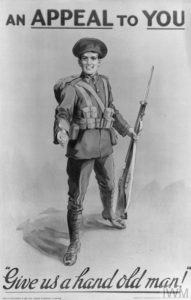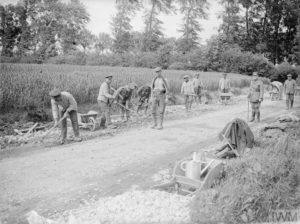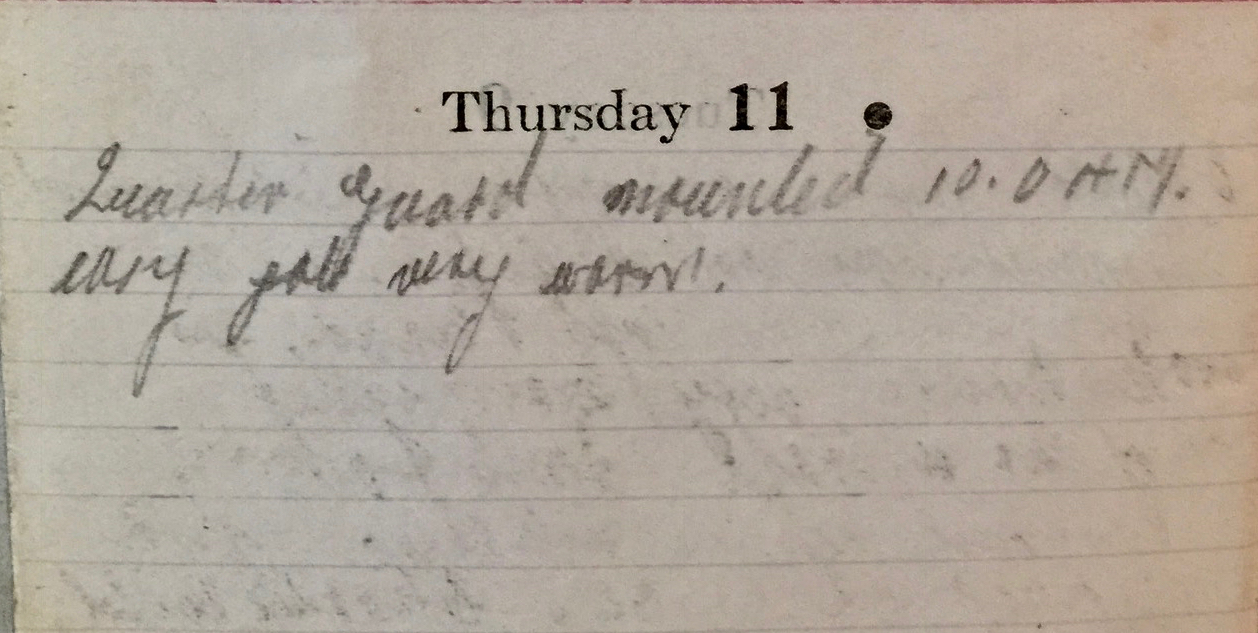Thursday April 11th, 1918
Quarter Guard mounted 10am. Very, very warm.
Raising an Army – Conscription & Rehabilitation

In February 1918 the British Government was worried about the release of Germany from the Russian front and the impact it would have on the balance of their forces on the Western Front. This concern would be vinicated by the German Spring Offensive launched the following month. Therefore, the Army Estimates being debated in Parliament, were asking for a total of 5,000,000 men for land forces, including the air forces, at home and abroad. Mr Macpherson, the Undersecretary of State for Warº, spoke to the House and his comments were summarized in the Guardian on February 21st, 1918¹:
‘As to personnel, the House had a fair idea of the number of troops at present on the various fronts. The outstanding feature was the willingness of the men of the country to submit themselves to the rigours of military discipline, and it was remarkable on how few occasions the provisions of the Army Act had had to be applied.’ ¹ This appears to refer to the ‘Military Services Act’ which introduced conscription in 1916. Over the course of the war 2.6 million men would volunteer and 2.3 million be conscripted. The sort of poster shown here helped encourage volunteers, this is from an Irish Election. Its slogan ‘Give us a hand old man!’ is especially pertinent as the current upper age limit for recruits is already 41 and, by April, will be raised to 50.
‘The Suspension of the Sentences Act had worked well. Under it many soldiers had been enabled to rehabilitate their characters by duty in the field.’ ¹ This Act was passed in 1915 specifically for the Army. It was enacted to prevent crime being committed to avoid active service, however lawmakers, including Macpherson here, positioned its intent more positively, in terms of redemption: Not only did it avoid wastage of able-bodied men, it also gave a convicted soldier the opportunity to redeem his character and have commuted even the harshest of sentences, including the death penalty for desertion.
Opportunties and Health
‘During the last ten months 48,452 commissions to officers and 6,435 warrants to warrant officers had been issued; 25,000 second lieutenants had been promoted to full lieutenants.’¹ Over the course of the war, almost a quarter of a million men will be commissioned. The highest rank below an officer is a Warrant Officer (holding the King’s ‘warrant’ rather than his ‘commission’) There are two classes, WOI and WOII. Sergeant Majors would typically be the more senior WOI and Quartermaster Sergeants, WOII. Most would also have an appointment that appeared as a prefix or suffix to their warrant (e.g Regimental, Farrier or Armourer).
‘The work of the Royal Army Medical Corps had been splendid. The amount of sickness in Salonika had been reduced by two-thirds of what it was in the previous year.’ ¹ RAMC and the Royal Engineers deployed a variety of strategies to reduce the impact of malaria on the troops. The reality was that combat-related casualties in Macedonia amounted to only 5% of the total. Of non-combat related illness, malaria was always number one.

‘Commanders gave their men as much leave as possible, and in the last four weeks over 200,000 men had had 14 days’ leave.’¹ As we know already, this was a bone of contention to troops in far-flung theatres of war. Leave for the Tommy was virtually unheard of in the BSF. At best they might get a few days in the city of Salonika. Officers fared better but home leave remained rare.
‘The Labour Corps now comprised 350,000 men of all classes, castes and creeds.’¹ The Labour Corps was formalized in early 1917. By the end of the war it would be closer to 400,000 with about 40% serving in theatres of war and the rest in the UK. This photograph shows troops of the Labour Corps working on the Hazebrouck Road near Bailleul in June 1916.*
Hurt & Healing
The following extract need no further explanation and is a sign of the times:
‘Under the heading of tobacco 8,500,000 lb of pipe and chewing tobacco and 11,000,000 lb of cigarettes were purchased. The War Office … had purchased 67,000,000 bandages, 2,000,000 ounces of quinine, and 4,700,000 lb of cotton wool.’¹
13th (Service) Battalion War Diary – 11th April 1918 – Saida
Work and training as before. The Battalion is now responsible for a new lot of screening, viz – all screens between Saida and Sector HQ at Crow Hill also from the top end of Gun Ravine to the Fountain at Shelter Ravine. All these screens are to be sufficiently high to conceal mounted men from the Pip Ridge or any other enemy view.
References & Further Reading
º Ian Macpherson (Liberal MP, Ross & Cromarty) was Undersecretary of State for War between 1916-1918
¹’Committee of Supply’ about the Army Estimates, Mr Macpherson’s comments, The Guardian, February 21st, 1918, page 8
* Q 647, Labour Corps in France, copyright IWM
# Q 70590, Irish Poster, copyright IWM


